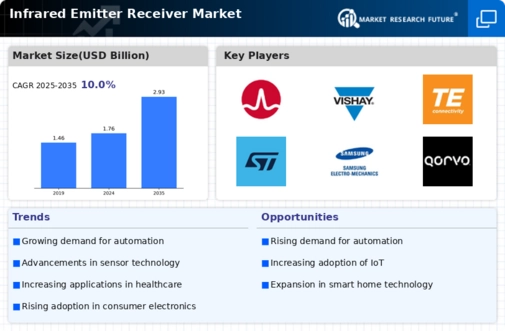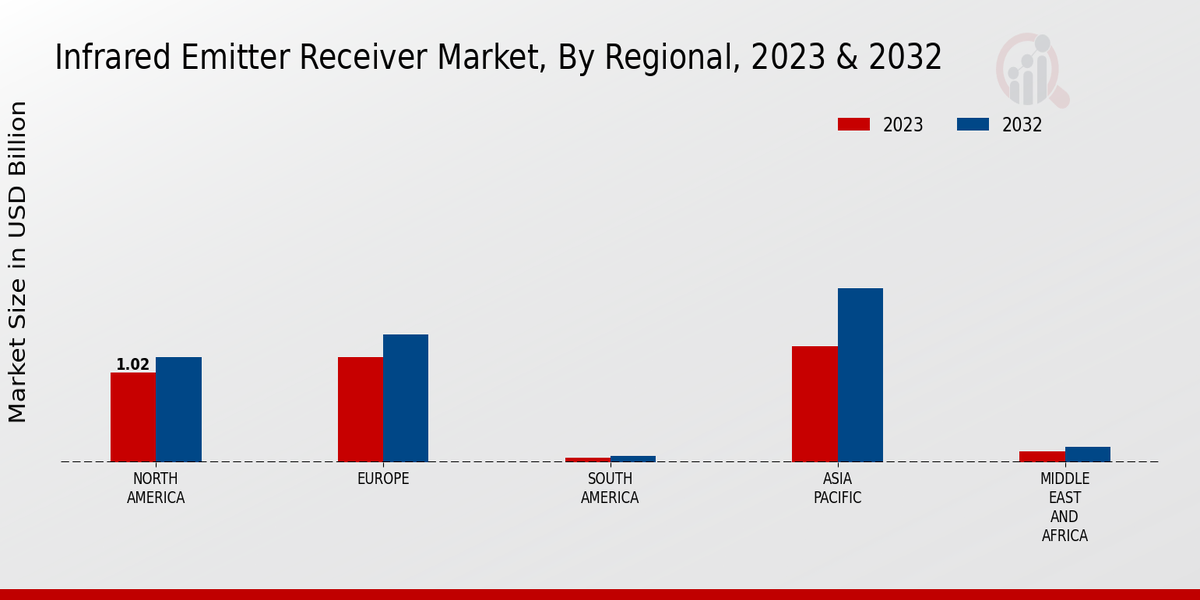Technological Advancements
The Global Infrared Emitter Receiver Market Industry experiences a robust growth trajectory due to continuous technological advancements. Innovations in infrared technology enhance the efficiency and performance of emitters and receivers, leading to wider applications across various sectors. For instance, the integration of infrared sensors in consumer electronics and automotive systems has become increasingly prevalent. As a result, the market is projected to reach 1.76 USD Billion in 2024, with a compound annual growth rate (CAGR) of 4.74% anticipated from 2025 to 2035. This growth is indicative of the industry's adaptability to emerging technologies and consumer demands.
Healthcare Sector Utilization
The healthcare sector's growing reliance on infrared technology significantly influences the Global Infrared Emitter Receiver Market Industry. Infrared emitters and receivers are employed in various medical devices, including thermometers, imaging systems, and patient monitoring equipment. The ability to provide non-invasive measurements and real-time data enhances patient care and operational efficiency. As healthcare technology advances, the demand for infrared solutions is expected to rise, contributing to the market's projected growth. This trend underscores the importance of infrared technology in improving healthcare outcomes and the industry's adaptability to evolving medical needs.
Growth in Automotive Applications
The automotive sector plays a pivotal role in driving the Global Infrared Emitter Receiver Market Industry. With the rise of advanced driver-assistance systems (ADAS) and autonomous vehicles, infrared technology is increasingly utilized for obstacle detection, night vision, and passenger safety features. The integration of infrared sensors enhances vehicle safety and efficiency, appealing to manufacturers and consumers alike. As the automotive industry evolves, the demand for infrared solutions is expected to surge, contributing to the market's growth. This sector's expansion is likely to be a key factor in achieving the projected market value of 2.93 USD Billion by 2035.
Rising Demand in Consumer Electronics
The increasing demand for consumer electronics significantly propels the Global Infrared Emitter Receiver Market Industry. Devices such as remote controls, smart home systems, and wearable technology utilize infrared emitters and receivers for seamless operation. The proliferation of smart devices, particularly in developed regions, underscores this trend. As consumers seek enhanced connectivity and automation, the market is poised for expansion. By 2035, the market is expected to reach 2.93 USD Billion, reflecting the growing reliance on infrared technology in everyday life. This trend highlights the industry's responsiveness to consumer preferences and technological integration.
Emerging Applications in Industrial Automation
The Global Infrared Emitter Receiver Market Industry is witnessing growth due to emerging applications in industrial automation. Infrared technology is increasingly utilized in manufacturing processes for object detection, quality control, and safety monitoring. As industries seek to enhance operational efficiency and reduce downtime, the adoption of infrared solutions is likely to increase. This trend is indicative of the broader shift towards automation and smart manufacturing practices. The market's expansion in this sector may contribute to achieving the anticipated market value of 2.93 USD Billion by 2035, reflecting the industry's alignment with industrial innovation.






















Leave a Comment